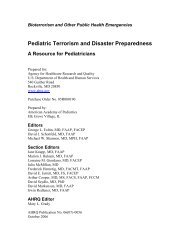(HPP) Performance Measure Manual
(HPP) Performance Measure Manual
(HPP) Performance Measure Manual
You also want an ePaper? Increase the reach of your titles
YUMPU automatically turns print PDFs into web optimized ePapers that Google loves.
APPENDIX A<br />
Pharmaceutical Cache: A collection of pharmaceuticals, antidotes, and medical supplies designed to<br />
provide rapid delivery of a broad spectrum of assets for an ill-defined threat in the early hours of an<br />
event. Prophylactic pharmaceutical caches can protect healthcare workers from illness, allowing them to<br />
continue delivering important healthcare services. In addition, providing prophylaxis to healthcare<br />
workers’ families enhances response by theoretically allowing the worker to remain on duty rather than<br />
having to care for an ill family member.<br />
Prophylaxis: A medical or public health procedure undertaken to prevent, rather than treat or cure, a<br />
disease.<br />
Recovery Processes: Those capabilities necessary to assist communities affected by an incident to<br />
recover effectively, including, but not limited to, rebuilding infrastructure systems; providing<br />
adequate interim and long-term housing for survivors; restoring health, social, and community<br />
services; promoting economic development; and restoring natural and cultural resources<br />
(http://www.fema.gov/pdf/recoveryframework/ndrf.pdf). Examples include: the development,<br />
coordination, and execution of service- and site-restoration plans; the reconstitution of government<br />
operations and services; individual, private-sector, nongovernmental, and public assistance programs to<br />
provide housing and promote restoration; long-term care and treatment of affected persons; additional<br />
measures for social, political, environmental, and economic restoration; evaluation of the incident to<br />
identify “lessons learned”; post incident reporting; and development of initiatives to mitigate the effects<br />
of future incidents.<br />
Resilience: The ability of an asset, system, network or function, to maintain its capabilities and function<br />
during and in the aftermath of an all-hazards incident. (Healthcare Preparedness Capabilities)<br />
Situational Awareness: The ability to identify, process, and comprehend the essential information about<br />
an incident to inform the decision making process in a continuous and timely cycle and includes the<br />
ability to interpret and act upon this information.<br />
Supply Chain: A system of organizations, people, technology, activities, information, and resources<br />
involved in moving a product or service from supplier to customer.<br />
Surge Capacity: The ability to evaluate and care for a markedly increased volume of patients—one that<br />
challenges or exceeds normal operating capacity. Requirements may extend beyond direct patient care<br />
to include other medical tasks, such as extensive laboratory studies or epidemiologic investigations.<br />
Trigger: An event which initiates certain actions.<br />
Hospital Preparedness Program (<strong>HPP</strong>) <strong>Performance</strong> <strong>Measure</strong> <strong>Manual</strong><br />
Guidance for Using the New <strong>HPP</strong> <strong>Performance</strong> <strong>Measure</strong>s Page | 60
















